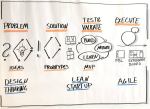“Design Thinking stand apart in their willingness to engage in the task of continuously redesigning their business to create advances in both innovation and efficiency.”
Innovation drives the world forward. It is what heals illnesses, protects individuals from danger, and makes life easier, more efficient, and more enjoyable.
Innovation never happens inside a vacuum. In some cases, Innovation is a response to a specific problem. In others, it’s driven by a creative’s imagination, someone who looks at a product or a process and thinks…
“we could be doing this better.”
To put it another way, Innovation requires a catalyst, and one of the most robust catalysts is Design.
“Innovation By Design” is the utilization of a designer’s methods and sensibility to address the needs of the consumer. Along with this design-driven approach, strong business strategy and technological feasibility are used to create both market opportunity and customer value.
Basically, the goal is to solve more complex problems with the methodology of a designer. This methodology is solution-based rather than problem-based. The aim is to find what actions will create the desired results. Exploration of the most beneficial outcomes is accomplished with everything from systemic reasoning and imagination to intuition and logic.
Design Innovation Supports Creativity
Having a few dreamers on your team can have many practical purposes, especially in highly competitive industries like manufacturing or tech. Innovation design is about finding solutions, and the companies that offer the best solutions to consumer problems are much more likely to succeed.
Design Innovation often works backward. Instead of creating a new product and then “selling” it to the public, innovative design is a process of identifying, pinpointing, and understanding the needs of the user or audience. Once the need has been identified, a solution can then be designed. This is where the brainstorming starts, and this when you need your creatives.
Creative design needs to be innovative and imaginative, but it must always be rooted in practicality. It doesn’t matter how beautiful or smart your ideas are. If they don’t offer a solution to a problem, or if they don’t have a practical use, then they are virtually worthless. A new design will only be successful if it ensures usefulness and market acceptance. Smartphones are a perfect example. The technology is impressive, but the fact we can carry it inside our pockets is what makes a smartphone such an amazing product.
Innovative Design Is Important To Development
Design Thinking is at the heart of some of the world’s most successful and influential companies, including Apple and Google. Leading universities are now teaching design innovation and many different organizations, big and small, are implementing new corporate cultures based around continuous improvement at every level.
Innovation powers economies and economies power the development of entire nations and their peoples. In a highly competitive global economy, businesses can no longer afford to stand still. Instead, they must always be looking forward and developing sustainable long-term solutions. This approach ensures company growth, while also contributing to the broader development of the industry and even to the lives of their customers.
Design Innovation is essentially about inclusion. It wants to find as many practical solutions to as many different problems as possible. Therefore, by its very nature, it cannot be exclusive or discriminator. We all experience exclusion in more ways than one. How we practice inclusive design shapes us as leaders, designers, and engineers in the world.
Innovative Design Solves Problems
A good design project should always start with the same question: what’s the problem? Once that’s been answered, it’s time to start looking for a solution. This can be as simple as designing a stronger but lighter protective case for a smartphone. Alternatively, it can be as profound as finding better ways for people to interact on social media. For example, Twitter CEO Jack Dorsey recently spoke about the platforms “echo-chamber” effect and how it’s creating deeply divided societies defined by internal conflict rather than cohesive narratives. One of Twitter’s future design aims is to encourage users to engage with all sides of the political or cultural debate.
Despite its many benefits, Social Media has created problems that very few people could have predicted. And these new problems require a new way of thinking about Innovation and Design. The world is becoming ever more connected through digital technologies, with information being increasingly exchanged horizontally rather than vertically. This switch from hierarchical structures to more open source models demands a different type of thinking that is flexible and non-linear.
Final Thoughts
What we need are new choices – new products that balance the needs of individuals and of society as a whole; new ideas that tackle the global challenges of health, poverty, and education; new strategies that result in differences that matter and a sense of purpose that engages everyone affected by them. It is hard to imagine a time when the challenges we faced so vastly exceeded the creative resources we have brought to bear on them.
Design innovators have always found practical solutions to contemporary problems, but the next few generations of creatives will need to find answers to questions that we never knew existed.
🅐🅚🅖
Interested in Management, Design or Technology Consulting, contact anil.kg.26@gmail.com
Get updates and news on our social channels!
LATEST POSTS
- A Tale Of Two Frameworks: Spring Boot vs. Django
 “Spring Boot’s convention over configuration approach simplifies development, allowing developers… Read more: A Tale Of Two Frameworks: Spring Boot vs. Django
“Spring Boot’s convention over configuration approach simplifies development, allowing developers… Read more: A Tale Of Two Frameworks: Spring Boot vs. Django - Unleashing The Power Of Django
 “Django, akin to a Swiss Army knife, provides a comprehensive… Read more: Unleashing The Power Of Django
“Django, akin to a Swiss Army knife, provides a comprehensive… Read more: Unleashing The Power Of Django - Potential of Progressive Web Apps (PWAs)
 “PWAs are not just about technology; they are about creating… Read more: Potential of Progressive Web Apps (PWAs)
“PWAs are not just about technology; they are about creating… Read more: Potential of Progressive Web Apps (PWAs) - Unleashing The Power Of Spring Framework
 “Spring Framework simplifies enterprise Java development, but it does so… Read more: Unleashing The Power Of Spring Framework
“Spring Framework simplifies enterprise Java development, but it does so… Read more: Unleashing The Power Of Spring Framework - Key Trends Of OSINT In 2024
 “The future of OSINT lies in our ability to adapt… Read more: Key Trends Of OSINT In 2024
“The future of OSINT lies in our ability to adapt… Read more: Key Trends Of OSINT In 2024 - Can Google’s Carbon Language Replace C++?
 “While Carbon may excel in performance-critical domains, it cannot replace… Read more: Can Google’s Carbon Language Replace C++?
“While Carbon may excel in performance-critical domains, it cannot replace… Read more: Can Google’s Carbon Language Replace C++? - Integration of Design Thinking, Lean, and Agile
 “Innovation thrives when Design Thinking, Lean, and Agile converge, creating… Read more: Integration of Design Thinking, Lean, and Agile
“Innovation thrives when Design Thinking, Lean, and Agile converge, creating… Read more: Integration of Design Thinking, Lean, and Agile - Benefits Of Infrastructure as Code (IaC)
 “Infrastructure as Code is the single most important thing you… Read more: Benefits Of Infrastructure as Code (IaC)
“Infrastructure as Code is the single most important thing you… Read more: Benefits Of Infrastructure as Code (IaC) - Power Of Internet of Everything (IoE)
 “The true power of the Intebrnet of Everything lies not… Read more: Power Of Internet of Everything (IoE)
“The true power of the Intebrnet of Everything lies not… Read more: Power Of Internet of Everything (IoE) - How Is The Enterprise IoT Evolving?
 “IoT is not just about connecting things; it’s about connecting… Read more: How Is The Enterprise IoT Evolving?
“IoT is not just about connecting things; it’s about connecting… Read more: How Is The Enterprise IoT Evolving? - IT Pricing Strategy And Models
 “The art of pricing lies in finding the perfect balance… Read more: IT Pricing Strategy And Models
“The art of pricing lies in finding the perfect balance… Read more: IT Pricing Strategy And Models - What Is SYCL (“sickle”)?
 “SYCL provides a powerful and intuitive programming model that simplifies… Read more: What Is SYCL (“sickle”)?
“SYCL provides a powerful and intuitive programming model that simplifies… Read more: What Is SYCL (“sickle”)? - What Is A Data Lakehouse?
 “With a data lakehouse, organizations can break down data silos,… Read more: What Is A Data Lakehouse?
“With a data lakehouse, organizations can break down data silos,… Read more: What Is A Data Lakehouse? - 5G – The Future Of The Internet
 “5G is the next big step in the evolution of… Read more: 5G – The Future Of The Internet
“5G is the next big step in the evolution of… Read more: 5G – The Future Of The Internet - Ransomware Groups Are Switching To Rust
 “Rust is to Ransomware what a lockpick is to a… Read more: Ransomware Groups Are Switching To Rust
“Rust is to Ransomware what a lockpick is to a… Read more: Ransomware Groups Are Switching To Rust - Streaming Data Pipelines
 “A streaming data pipeline is like a river: it flows… Read more: Streaming Data Pipelines
“A streaming data pipeline is like a river: it flows… Read more: Streaming Data Pipelines - Why Rust Is Best?
 “Rust is a systems programming language that runs blazingly fast,… Read more: Why Rust Is Best?
“Rust is a systems programming language that runs blazingly fast,… Read more: Why Rust Is Best? - Database Sharding Explained
 “Database sharding is like breaking a large puzzle into smaller,… Read more: Database Sharding Explained
“Database sharding is like breaking a large puzzle into smaller,… Read more: Database Sharding Explained - Ambient Computing Will Be The Future Tech
 “Ambient computing creates a seamless technology-rich environment, but challenges in… Read more: Ambient Computing Will Be The Future Tech
“Ambient computing creates a seamless technology-rich environment, but challenges in… Read more: Ambient Computing Will Be The Future Tech - Key Trends Of OSINT In 2023
 “OSINT is not just a technique, it’s a mindset. It’s… Read more: Key Trends Of OSINT In 2023
“OSINT is not just a technique, it’s a mindset. It’s… Read more: Key Trends Of OSINT In 2023

